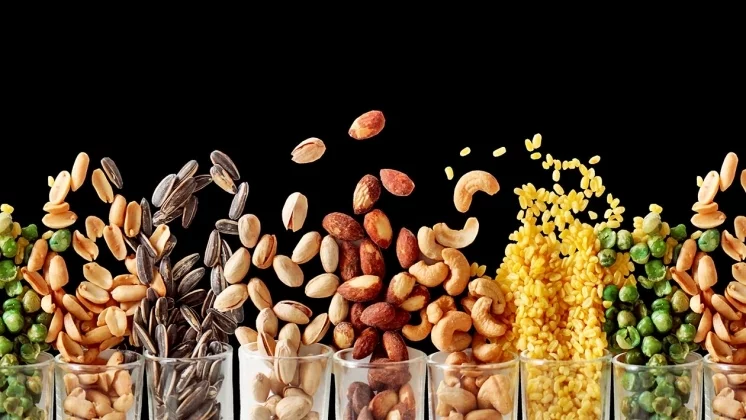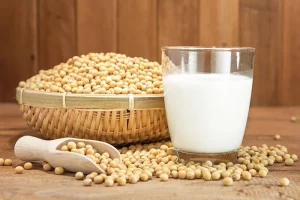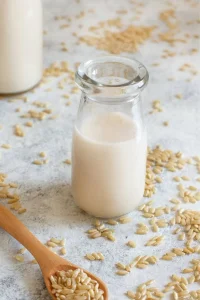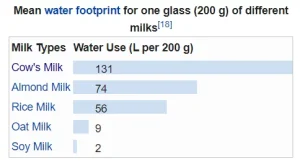The number of people choosing non-dairy, plant-based substitutes for cow’s milk seems to have increased. So what is the nutritional value of plant-based drinks and how do they differ from animal-based milk? Which plants can they come from and what are the differences between them? Finally, what is the environmental impact of animal milk production compared to the production of plant-based drinks?
Definition
Today many people choose plant-based beverages over cow’s milk. One reason for this change is the growing concern about the health risks of consuming dairy products. Lactose intolerance is another reason to avoid drinking cow’s milk. Those who are lactose intolerant have difficulty digesting milk. Also, a small percentage of adults and children are allergic to cow’s milk protein. Below we will discuss some of the most basic types of plant-based drinks consumed worldwide and available on the market. If you haven’t read the article on animal milk and lactose intolerance, click here.
Plant-based alternative milks, or more correctly, beverages, are liquids derived from the crushing (reduction in size) of plant matter (grains, pseudo-grains, legumes, oilseeds, nuts) and extracted in water. These drinks mimic cow’s milk in appearance and consistency. Plant-based “milks” are vegetarian beverages consumed as plant-based alternatives to milk of animal origin.
It is therefore understood that these are non-animal products and cannot be classified as ‘milk’ within the European Union. In practice, the term ‘milk’ simply means only cow’s milk, which has specific characteristics under the Food and Drink Code. Of course, traditionally, a variety of non-dairy products have been described by the word milk, including the traditional digestive medicine ‘milk of magnesia’, simply because of the similarity in texture.
Plant-based beverages have been consumed for centuries, with the term ‘milk-type plant juices’ being used since the 13th century. In various cultures, plant milk has been both a traditional drink and a flavouring ingredient in sweet and savoury dishes, such as the use of coconut milk in curry dishes.
Among the 20 or so plants used to produce plant-based beverages, almond, soy and coconut were the best-selling plant-based beverages worldwide. As of late 2020, the oat beverage market surpassed soy beverage sales to become the second largest among plant-based beverages, after the leading almond beverage.
Types
The most common herbal beverages that will be analyzed below, which are consumed and even circulated in the Greek market, are almond, soy, coconut, rice and oat. Other herbal drinks that can be found in the market include sesame, peanut, hazelnut, hemp, Aegina peanut, walnut and various combinations of these.

Production
Although there are variations in the production of herbal beverages depending on the original plant material, as an example, a general technique involves several steps, such as:
cleaning, soaking and peeling of the vegetable raw material
milling of the vegetable raw material to produce a pulp, powder or emulsion
heating of the processed vegetable material to denature the lipoxidase enzymes in order to minimise their effect on flavour
removal of the solid precipitate by filtration
addition of water, sugar (or sugar substitutes) and other ingredients to improve taste, flavour and nutrient content
pasteurisation of the pre-finishing liquid
homogenisation of the liquid to break up fatty globules and particles for a smooth mouthfeel
packaging, labelling and storage at 1 °C
Other ingredients commonly added to herbal beverages during preparation include gums (guar, xanthan gum, etc.) for stability, texture and mouthfeel, selected micronutrients (such as calcium, B vitamins and vitamin D), salt and natural or artificial ingredients for aroma, colour and flavour.
Nutritional comparison with cow’s milk
Generally, because plant-based beverages are made using processed extracts of the original plant, they have a lower nutrient content than animal milk and are fortified during manufacture to add precise levels of micronutrients.
Although they are nutritious to a satisfactory degree, consumers should be aware that plant-based beverages are not an accurate substitute for cow’s milk. This is particularly important with regard to consumption by children.
| Nutritional content* in cow’s milk, almond milk, soy, coconut, rice, oat milk | ||||||
| Type of milk /
content per 100g |
Cow | Almond | Soy | Coconut | Rice | Oat |
| Energy, kJ / kcal | 275 / 66 | 63 / 15 | 180 / 43 | 130 / 31 | 197 / 47 | 209 / 50 |
| Water, g | 87,6 | 96,5 | 90,4 | 94,6 | 89,3 | 89 – 94 |
| Fat, g | 3,3 – 4,0 | 0,96 | 1,47 | 2,08 | 0,97 | 2,08 |
| Protein, g | 3,3 | 0,4 | 2,6 | 0,21 | 0,28 | 1,25 |
| Carbohydrates, g | 4,8 | 1,31 | 4,92 | 2,92 | 9,17 | 6,67 |
| of which Sugars, g | 4,8 | 0,81 | 3,65 | 2,5 | 5,28 | 2,92 |
| Cholesterol, mg | 14 | 0 | 0 | 0 | 0 | 0 |
| Calcium, mg | 120 | 184 | 123 | 188 | 118 | 146 |
| Sodium, mg | 50 | 72 | 47 | 19 | 39 | 42 |
| Potassium, mg | 153 | 67 | 122 | 19 | 27 | 162 |
| Edible fibres, g | 0 | 0,2 | 0,2 | 0 | 0,3 | 0,8 |
*indicative values
Almond drink

The almond drink was first invented in the Middle East and appears in cookbooks from the region from the 13th century onwards. From there its preparation spread to Europe until the 14th century. In the Middle Ages, the almond drink was known in both the Islamic and Christian worlds. As a dried fruit, almonds are permitted for consumption by these religions during fasting periods such as Ramadan and Lent. Almond drink became the staple of medieval cuisine because cow’s milk could not be preserved for long periods of time without spoiling.
Almonds are a very nutritious product and are an excellent source of vitamin E (in the form of alpha-tocopherol) and manganese. They are also a rich source of other nutrients such as calcium, magnesium, selenium, potassium, zinc, phosphorus and copper.
It contains no cholesterol, saturated fat or lactose and is often consumed by people who are lactose intolerant and other people, such as vegans, who avoid dairy products. Commercial almond drink comes in sweetened or unsweetened forms, vanilla and chocolate flavours and is usually fortified with micronutrients. Almond drink is extremely low in calories, fat and protein, which makes it not suitable for everyone, especially children. By adding almond drink to hot beverages, such as coffee, the separation of the almond drink’s components can be observed.
Soy drink

Soy drink is a herbal drink made from soybeans. In its original form it began as a by-product of tofu production, a product from East Asia, mainly China. It was around 1365 that this traditional watery drink and the drinks produced as a by-product of tofu production first appeared under the name ‘bean broth’. Its popularity grew and by the 18th century, it was so popular that it was sold by street vendors. Its production process was industrialized in 1929 in China and became a common beverage in Europe and North America in the late 20th century. The soy drink spread to European and American grocery stores, initially as a substitute for dairy products due to the absence of lactose.
To mask the bean flavor in the drink, manufacturers sometimes added other flavors and sugars. New technology and new production techniques have made possible a process of reducing or eliminating bean flavour from commercial products. Thus, it was in the mid-1980s that soy beverage began to have a noticeably better taste and a more dairy-like texture.
It is generally opaque, white or off-white in colour and has about the same consistency as cow’s milk. The fresh soy beverage may be present with added sweeteners, flavoured and fortified with micronutrients. Soy beverage is a good source of much needed monounsaturated and polyunsaturated fatty acids, which are considered good for cardiovascular health. Soy beverage has the highest amount of protein among the plant-based beverages and is comparable to cow’s milk. Soy protein, judging by its nutritional value, is considered by the World Health Organization to be of similar quality to animal protein.
Along with similar plant-based “milks”, soy beverage can be used as a substitute for animal milk by vegan or lactose intolerant individuals, while other individuals may consume it for environmental or health reasons.
Coconut drink

Coconut drink should not be confused with coconut milk, which is mainly used in cooking and is not consumed as a beverage on its own. Coconut milk is an opaque, milky white liquid extracted from the grated pulp of ripe coconuts. Its opacity and rich taste are due to its high oil content, which is mainly saturated fat. Coconut milk is a traditional food ingredient used in Southeast Asia, Oceania, South Asia and East Africa. It is also used for cooking in the Caribbean, tropical Latin America and West Africa. Coconut milk can also sometimes be confused with coconut water. Coconut water is the clear liquid found inside the coconut seed, while milk is the extracted liquid resulting from the manual or mechanical crushing of coconut pulp. Coconut beverages used as milk substitutes are basically coconut milk diluted with water or skim coconut milk with additives.
Coconut is a nutrient-rich product and a good source of fibre. Coconut milk is equally rich in vitamins and minerals such as iron, calcium, potassium, magnesium and zinc. It contains significant amounts of vitamin C and E. Coconut drink contains less fat and fewer calories than coconut milk, but it also has less protein. It contains high amounts of potassium and is a good source of fiber and iron. It is usually fortified with vitamin D and calcium. It is a rich source of manganese and an adequate source of phosphorus and magnesium.
In a 100 mL serving, coconut drink is lower than other plant-based drinks in calories and protein, but high in fat and calcium.
Many health organizations discourage people from consuming significant amounts due to high levels of saturated fat. Excessive consumption of coconut beverage can increase blood cholesterol levels.
Rice drink

The commercial rice drink is usually made using brown rice and brown rice syrup. It can be sweetened using sugar or sugar substitutes and flavoured with common ingredients such as vanilla. It is usually enriched with protein and micronutrients such as vitamin B12, calcium, iron or vitamin D.
Rice milk is the least allergenic among plant-based drinks and is safe to consume for people who are lactose intolerant, allergic to soy or milk. Read about allergenic food ingredients here.
Rice milk (unsweetened) is 89% water, 9% carbohydrate, 1% fat and contains negligible protein. Compared to cow’s milk, rice milk contains more carbohydrates (9% vs. 5%), but no significant amounts of calcium or protein and no cholesterol or lactose. Compared to other plant-based drinks, it contains the highest amount of carbohydrates and sugars.
Oat drink

Oat drink is a plant-based drink derived from the seeds of oats (Avena spp.) by extracting the plant material with water. The oat drink has a creamy texture and flake-like taste and comes in various types, such as sweetened, unsweetened, vanilla or chocolate flavoured.
Unlike other plant-based drinks that started to be produced as early as the 13th century, the oat drink was developed in the 1990s by a Swedish food scientist.
The growth in the oat drink market is partly due to the relatively low environmental impact, low land and water requirements and the increasing vegetarian dietary practices in developed countries.
Unflavoured oat drink has a very high amount of calories and carbohydrates compared to other plant-based drinks (only rice drink has more). It also has a high amount of sugars, which are of natural origin. Compared to cow’s milk, oat milk is similar in total calories per volume of liquid (per 100 mL serving, 50 versus 66 calories for cow’s milk). It has half the protein content, somewhat less total fat, but only about 10% of the saturated fat content. It contains about 1.5 times as many carbohydrates as milk (although simple sugars are half the amount of cow’s milk). Cow’s milk has no fiber, but oat milk has 2 g of dietary fiber per serving (~250 mL). The calcium and potassium content is comparable, although the oat drink does not naturally have calcium, which is an essential nutrient for growth. For this reason, oatmeal – like all plant-based beverages – can be fortified with specific nutrients during its preparation if it is to be used as a substitute for animal milk.
The health benefits of oats are related to their content of dietary fibre such as beta-glucan, which has been shown to lower cholesterol. Oats are a good source of quality protein with a good balance of amino acids. The protein contained in oats is similar to that found in legumes and equivalent to soy protein.
Oat drink is not suitable for consumption by people with gluten intolerance or celiac disease. The avenin present in oats (a protein similar to gliadin from wheat) can cause celiac disease. Also, oat products are often contaminated by other gluten-containing grains, mainly wheat and barley.
Oat drink is used as a good substitute for animal milk in the preparation of coffee. Oat drink requires less steam than cow’s milk, foams favorably, is flavorful, rich and creamy like cow’s milk, and effectively balances the acidity of espresso coffee.
Ecological impact of cow’s milk production versus plant production for beverages
The consumption of cow’s milk poses many threats to the natural environment. Compared to plant-based beverages, cow’s milk requires the most land and water. Also, cows need much more energy to produce milk, since the farmer has to feed and water the animals. Its production leads to the highest amount of greenhouse gas emissions, air and water pollution.
The emissions, land and water footprint of plant-based beverages vary due to differences in crop water needs, agricultural practices, production area, production processes and transport.

Among plant-based beverages, almond beverage requires much more water during the growth and production stages of the trees than soybean, rice or oat beverage.
Using soybeans for beverage production instead of growing cows is ecologically advantageous. Legumes, including the soybean plant, supplement the nitrogen content of the soil in which they are grown. Of course, soybean cultivation in South America is the cause of deforestation (especially in the Amazon rainforest) and a number of other large-scale environmental impacts. However, the majority of the world’s soybean cultivation, especially in South America where livestock farming is widespread, is for animal feed and not for soy beverage production.
Rice fields require significant water resources and may allow fertilizers and pesticides to migrate into adjacent watercourses. The bacteria that inhabit rice fields release methane into the atmosphere, emitting this greenhouse gas in quantities greater than other crops used to produce plant beverages. Rice drink production uses less water than animal milk and almond drink, but significantly more than soy or oat drink.
Compared to animal milk and other plant-based beverages, oat milk has a relatively low environmental impact due to its comparatively low land and water requirements for production. The production of oat drink requires 15 times less water than animal milk and 8 times less than almond drink.


With information from Wikipedia/plant milk and its components , Wikipedia/milk, U.S. Department of Agriculture, FoodData Central





